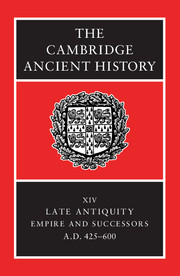Book contents
- Frontmatter
- PART I CHRONOLOGICAL OVERVIEW
- PART II GOVERNMENT AND INSTITUTIONS
- 6 Emperor and court
- 7 Government and administration
- 8 Administration and politics in the cities of the fifth to the mid seventh century: 425–640
- 9 Roman law
- 10 Law in the western kingdoms between the fifth and the seventh century
- 11 The army, c. 420–602
- PART III EAST AND WEST: ECONOMY AND SOCIETY
- PART IV THE PROVINCES AND THE NON-ROMAN WORLD
- PART V RELIGION AND CULTURE
- Conclusion
- Chronological Table
- BIBLIOGRAPHY
- Index
- References
9 - Roman law
from PART II - GOVERNMENT AND INSTITUTIONS
Published online by Cambridge University Press: 28 March 2008
- Frontmatter
- PART I CHRONOLOGICAL OVERVIEW
- PART II GOVERNMENT AND INSTITUTIONS
- 6 Emperor and court
- 7 Government and administration
- 8 Administration and politics in the cities of the fifth to the mid seventh century: 425–640
- 9 Roman law
- 10 Law in the western kingdoms between the fifth and the seventh century
- 11 The army, c. 420–602
- PART III EAST AND WEST: ECONOMY AND SOCIETY
- PART IV THE PROVINCES AND THE NON-ROMAN WORLD
- PART V RELIGION AND CULTURE
- Conclusion
- Chronological Table
- BIBLIOGRAPHY
- Index
- References
Summary
INTRODUCTION: LAW IN THE LATE ROMAN EMPIRE
Law was central to the social structure of the Roman empire in the fifth and sixth centuries a.d., more so than in the principate and in the neighbouring barbarian kingdoms. The administration of justice, and of finance, had been strengthened by the reduction in the size of provinces and by the reforms which both relieved governors of military responsibilities and provided them with a substructure of bureaucratic support. The legislative machine had also become more energetic. The legislative functions of the senate in Rome had been transferred to the imperial consistorium in Constantinople and Ravenna, which worked with more expedition and produced incomparably more enactments. The number was especially high at the beginning and towards the end of our period – that is, a.d. 425–60 and, even more so, 527–46. Tradition had by this time built up a vast store of legal literature, impressive alike in its volume, antiquity and quality. A civilized state, based on the rule of law, seemed on the surface of things to be assured, and this must have enhanced Roman pride. With the exception of the Vandals, one nation of Germanic barbarians after another sought to emulate this Roman ideal (see pp. 260–87 below).
- Type
- Chapter
- Information
- The Cambridge Ancient History , pp. 238 - 259Publisher: Cambridge University PressPrint publication year: 2001
References
- 3
- Cited by

